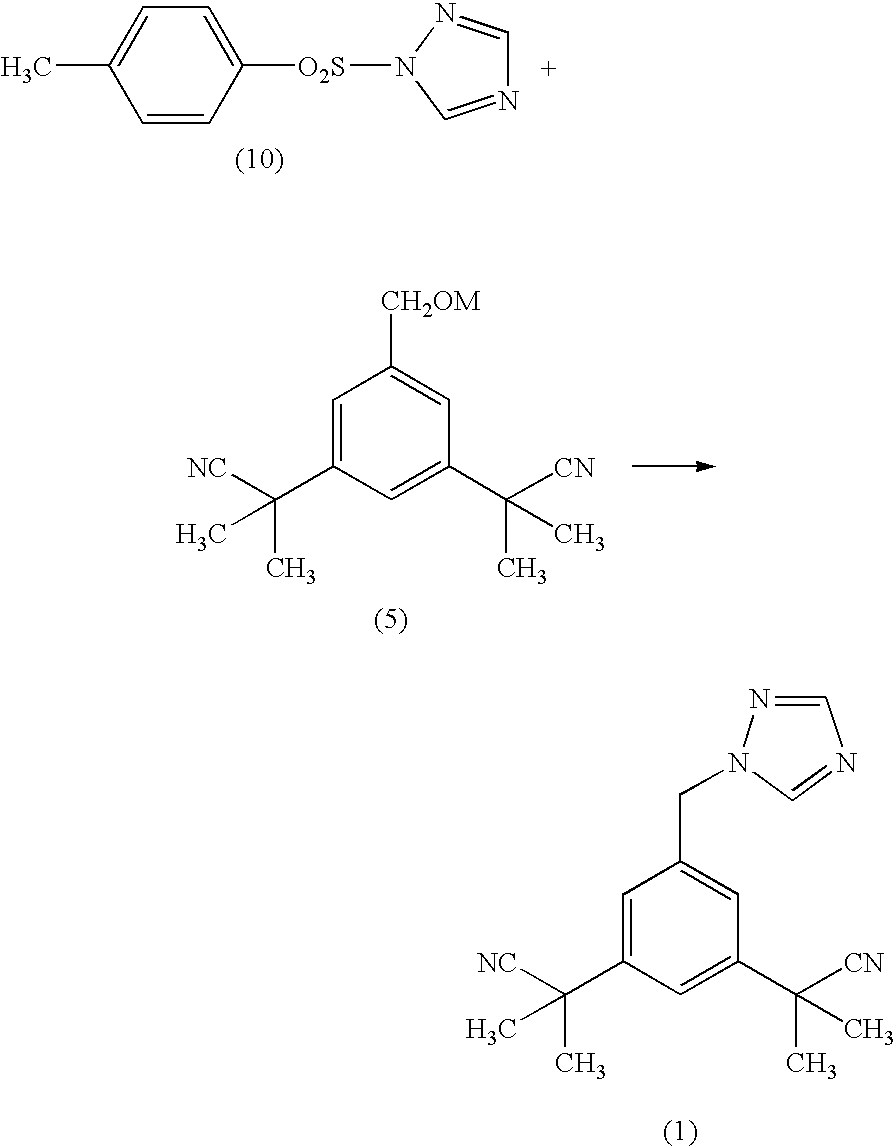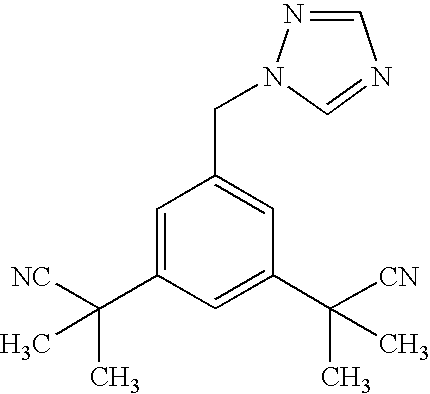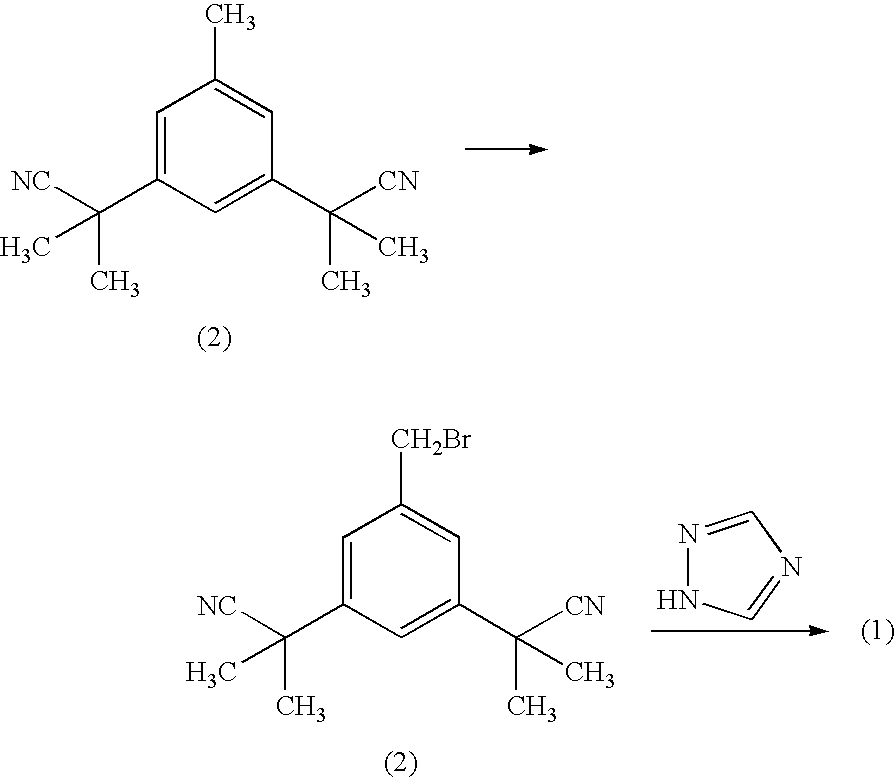Process for making anastrozole
a compound and anastrozole technology, applied in the field of compound anastrozole, can solve the problems of poor quality, repeated process with poor yield (50%), unviable industrial scale process, economic unattractive or unviable effect, etc., and achieve economic and ecological advantageous
- Summary
- Abstract
- Description
- Claims
- Application Information
AI Technical Summary
Benefits of technology
Problems solved by technology
Method used
Image
Examples
example 1
1-(p-toluenesulfonyl)-1,2,4-triazole (10)
[0035] 1,2,4-triazole (9.28 g) was suspended in dichloromethane (110 mL) dried over molecular sieves. Triethylamine (13.6 g) was added; the triazole dissolved after triethylamine addition. Tosylchloride (25.62 g;) was added to the reaction mixture over approx. 30 min. The reaction mixture was stirred overnight. Precipitated salt was filtered off. Filtrate was washed with water and dried with Na2SO4. The drying agent was filtered off and filtrate was evaporated on rotary evaporator. Cyclohexane (300 mL) was added to the residue and the mixture was allowed to crystallise overnight. Product was separated by filtration, washed with cyclohexane (50 mL), and dried in oven at 50° C. to give the title compound as white crystalline powder, 25.1 g (83.7% of theoretical yield; m.p. 105-107° C.
example 2
Synthesis of Anastrozole Mesylate
[0036] To a stirred solution of 2 g (8.25 mmol) of 2-[3-(cyano-dimethyl-methyl)-5-hydroxymethyl-phenyl]-2-methyl-propionitrile in 20 ml of dry tetrahydrofuran 0.248 g (8.25 mmol) of sodium hydride as 80% suspension in mineral oil was added. The mixture was heated to 70° C. for 30 minutes.
[0037] The mixture was then evaporated on rotary evaporator and solid residue was suspended in 10 mL of dimethylacetamide and 1.84 g (8.25 mmol) of 1-(p-toluenesulfonyl)-1,2,4-triazole was added portion-wise. The mixture was stirred 20 minutes at ambient temperature (the reaction is slightly exothermic).
[0038] Dimethylacetamide was evaporated under vacuum to leave viscous oily residue. The residue was partitioned between dichloromethane (20 mL) and water (20 mL). The layers were separated and dichloromethane layer was washed with water (20 mL). Aqueous layers were combined and washed with dichloromethane (20 mL). Combined dichloromethane layers were dried over Na2...
example 3
Synthesis of Anastrozole Mesylate
[0039] To stirred solution of 2 g (8.25 mmol) of 2-[3-(cyano-dimethyl-methyl)-5-hydroxymethyl-phenyl]-2-methyl-propionitrile in 20 ml of dry tetrahydrofuran 0.248 g (8.25 mmol) of sodium hydride as 80% suspension in mineral oil was added. The mixture was heated to 70° C. for 30 minutes.
[0040] To the solution of alcoholate cooled to 10° C. 1.84 g (8.25 mmol) of 1-(p-toluenesulfonyl)-1,2,4-triazole was added portion-wise. The mixture was stirred 20 minutes at ambient temperature, and then it was heated to 80 to 100° C. for 3 hours. The mixture was evaporated in vacuo, the remainder was partitioned between 20 ml dichloromethane and 20 ml of water. The organic extract was dried over magnesium sulfate. After filtering off the drying agent and evaporation in vacuo 2.6 g of crude anastrozole in the form of yellow oil was obtained.
[0041] The residue was dissolved in ethylacetate (20 mL) and such amount of methane sulfonic acid was gradually added until li...
PUM
| Property | Measurement | Unit |
|---|---|---|
| Polarity | aaaaa | aaaaa |
| Acidity | aaaaa | aaaaa |
Abstract
Description
Claims
Application Information
 Login to View More
Login to View More - R&D
- Intellectual Property
- Life Sciences
- Materials
- Tech Scout
- Unparalleled Data Quality
- Higher Quality Content
- 60% Fewer Hallucinations
Browse by: Latest US Patents, China's latest patents, Technical Efficacy Thesaurus, Application Domain, Technology Topic, Popular Technical Reports.
© 2025 PatSnap. All rights reserved.Legal|Privacy policy|Modern Slavery Act Transparency Statement|Sitemap|About US| Contact US: help@patsnap.com



